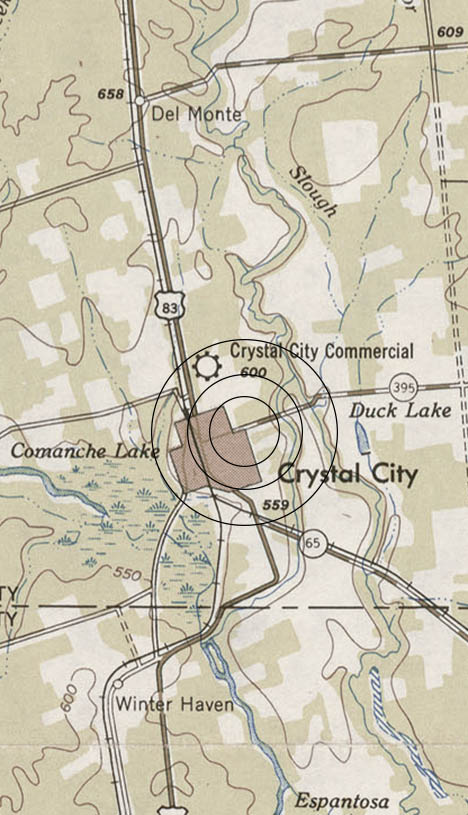Crystal City
Topographical Map, 1949. Crystal City, Texas. United States Geological Survey. Courtesy of the University of Texas at Austin, University of Texas Libraries. http://www.lib.utexas.edu/maps/topo/texas/c.html
Crystal City Internment Camp (U.S. government name) was located next to Crystal City, Zavala County, Texas. Today, the location of the camp would have been roughly bounded by Airport Drive and Popeye Lane, North 7th, and North 12th avenues (28°41′27″N99°49′22″W). The facility was originally a Farm Security Admission migrant labor camp. Crystal City was run by the Immigration and Naturalization Service (INS) from 1942 to 1948. Peak population was 4,000. By 1944, the camp held 2,104 persons of Japanese ancestry, nearly half of whom were forcibly taken from Peru, both Japanese immigrant residents and their children who were Peruvian citizens. Also held at this camp were persons of Japanese, German, and Italian ancestry from Hawai’i, other parts of the U.S., and Latin American countries. Unlike most other Department of Justice facilities, Crystal City was a family internment camp and boasted about the swimming pool constructed by the internees as an example of its child-friendly properties. In truth, the U.S. government provided little to no funds for textbooks or teachers for their schools.
At the end of the war, the U.S. government wanted to rid the Western Hemisphere of these “enemy aliens” from Latin America. Declaring them to have entered the U.S. illegally, the U.S. government proceeded to deport these “illegal aliens” to war-devastated Europe and Japan, even though many wanted to return to their homes in Latin America. Those internees of Japanese ancestry from Peru were initially denied return by the Peruvian government, even if they were Peruvian citizens or married to Peruvian citizens. With the help of Wayne M. Colllins, attorney for the Northern California American Civil Liberties Union, the deportations were halted for about 300 Japanese Peruvians. Many were granted parole out of camp to labor at Seabrook Farms in New Jersey.
The camp was the last to close, on February 27, 1948.
Sources:
Confinement and Ethnicity: An Overview of World War 2 Japanese American Relocation Sites

